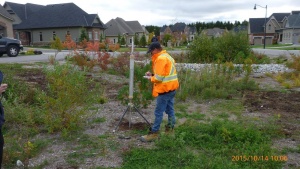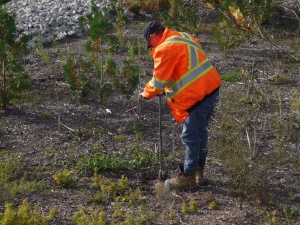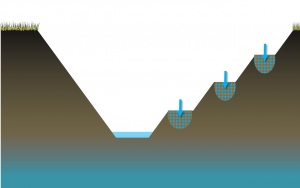Infiltration: Testing
Four Step Process[edit]
Soil infiltration testing is a four-step process to obtain the necessary information for stormwater management planning and design. The four steps include:
1. Background Evaluation
- Based on available published and site specific data;
- Includes consideration of proposed development plan;
- Used to identify potential BMP types, locations and soil test locations;
- Done prior to field work; and
- On-site soil tests may be done to identify/screen potential BMP locations.
2. Test Pit or Soil Boring Observations
- Includes multiple testing locations;
- Provides an understanding of sub-surface conditions; and
- Identifies limiting conditions (e.g., aquitard, bedrock or water table elevations).
3. Infiltration Testing
- Must be conducted on-site;
- Various testing methods are available; and
- Different testing methods for screening versus verification purposes.
4. Design Considerations
- Determination of a suitable infiltration rate for design calculations; and
- Consideration of desired BMP drawdown period.
Background Evaluation[edit]
Prior to performing testing and developing a detailed site plan, existing site conditions should be inventoried and mapped including, but not limited to:
- Surficial geology and underlying stratigraphy;
- Watercourses (perennial and intermittent), water bodies, wetlands and floodplains;
- Small headwater drainage features;
- Topography, slope, and drainage patterns;
- Existing land cover and land use;
- Natural heritage conservation areas; and
- Other man-made features or conditions that may impact design such as existing nearby structures (buildings, infrastructure, etc.).
A sketch plan or preliminary layout plan for the proposed development should be evaluated, including:
- The preliminary grading plan and areas of cut and fill;
- The location and water surface elevation of all existing, and location of proposed water supply sources and wells;
- The location of all existing and proposed on-site wastewater (septic) systems;
- The location of other features of note such as utility rights-of-way, water and sewer lines, etc.;
- Existing data from borehole, well and geophysical testing; and
- Proposed location of development features (buildings, roads, utilities, etc.).
Test Pit or Soil Boring Observations[edit]
Test pits or soil borings provide information regarding the soil horizons and overall soil conditions both horizontally and vertically in that portion of the site. Multiple observations can be made across a site at a relatively low cost and in a short time period.
Test pit excavations or soil borings should extend to a depth of between 2.5 to 5 metres below ground surface or until bedrock or fully saturated conditions are encountered. It is important that the tests provide information related to conditions at least 1.5 metres below the proposed bottom elevation of the infiltration BMP. Test pit trenches should be benched at 1 metre depth intervals for access and infiltration testing.
At each test location, the following conditions should be noted and described:
- Soil horizons (upper and lower boundary);
- Soil texture and colour for each horizon;
- Color patterns (mottling) and observed depth;
- Depth to water table (if encountered);
- Depth to bedrock (if encountered);
- Observations of pores or roots (size, depth);
- Estimated type and percent coarse fragments;
- Hardpan or other limiting layers; and
- Strike and dip of soil horizons.
The number of test pits or soil borings varies depending on site conditions and the proposed development plan. General guidelines are as follows:
- For infiltration BMPs with footprint surface areas from 50 to 900 square metres, a minimum of two test pits or one test pit and two soil borings are required at, or within 10 metres of the proposed location to determine the suitability and distribution of soil types present;
- For infiltration BMPs with footprint surface areas greater than 900 square metres, a minimum of one test should be conducted for each 450 square metres of footprint surface area. Tests should be conducted equidistant from each other to provide adequate characterization of the area;
- For linear infiltration BMPs a minimum of one test should be conducted within each soil mapping unit present along the proposed BMP location. Soil borings should be conducted every 50 metres and a test pit should be conducted every 450 metres; and
- For sites with multiple infiltration BMPs, each with footprint surface areas less than 50 square metres, a minimum of one test pit is required and one soil boring per infiltration BMP location is recommended.
Infiltration Testing[edit]
The preferred testing period is during April and May. If testing is conducted between June 1 and December 1, the soil should be soaked for 24 hours prior, to simulate field saturated conditions.[1]
- If uniform soil texture is observed in the proposed location, at least three percolation test holes should be prepared. If the soil texture changes within the area, make at least two test holes in each soil texture. All test holes should be uniformly spaced across the proposed area.
- Test holes should be between 150 - 200 mm in diameter, and penetrate to the depth of the proposed BMP. Observations should be made on the extracted soil and variations recorded.
- The lowest 300 mm and the bottom of the test pit should be scarified, and the loose material removed.
- A mesh bag containing about 1L of pea gravel may be lowered into the pit, to prevent scouring of the base. Attaching a line to the bag allows it to be removed and reused.
- Carefully pour 6 L of clean water into the base of the pit. A hose is recommended to prevent washing out or erosion of the sides.
- In sandy soils, where half the depth of water percolates within 30 minutes. Otherwise, calculate the infiltration rate
Design Considerations[edit]
This article discusses the determination of a suitable infiltration rate to describe the native soils surrounding a proposed infiltration practice.
It does not relate to the hydraulic conductivity or permeability of filter media or planting media used within vegetated BMPs.
The design infiltration rate (f') is used in all sizing calculations for bioretention and bioswales, dry ponds, infiltration trenches and chambers, and exfiltration trenches. It is related to, but not always synonymous with 'permeability', 'field hydraulic conductivity' (Kfc), or 'saturated hydraulic conductivity' (Ksat). Before application a safety correction factor (SCF) is incorporated into the figure, depending upon the source of the raw data, and the risk of failure of the finished practice.
It is highly recommended that testing be conducted on site.
| On site testing methods | Off site analysis methods | Unacceptable methods |
|---|---|---|
|
|
Becoming familiar with the different measurement practices[edit]
STEP have produced a free online module to provide some basic information on infiltration test methods. Access it HERE
Safety correction[edit]
To apply conservatism, the measured or calculated infiltration rate may be divided by a value between 2 and 3 before use in design calcualtions[2]
| Lower value (closer to 2) | Higher value (closer to 3) |
|---|---|
| Catchment < 100 m² | Catchment > 100 m²[3] |
| Permeameter or percolation test on site | Double ring infiltrometer test on site, or grain size analysis used [4] |
| Loamy or sandy soil texture | Clayey soil texture[5] |
| No variation in geologic formation, soil texture or soil bulk density within 1.5 metres below the proposed bottom elevation of the practice. | Variation in geologic formation, soil texture or soil bulk density within 1.5 metres below the proposed bottom eleation of the practice observed. |
| No nearby sensitive receptors | Sensitive receptors in near proximity (e.g. septic systems, building foundations). |
Planning for testing[edit]
Background Evaluation[edit]
Prior to performing testing and developing a detailed site plan, existing site conditions should be inventoried and mapped including, but not limited to:
- Surficial geology and underlying stratigraphy;
- Watercourses (perennial and intermittent), waterbodies, wetlands and floodplains;
- Small headwater drainage features;
- Topography, slope, and drainage patterns;
- Existing land cover and land use;
- Natural heritage conservation areas; and
- Other man-made features or conditions that may impact design such as existing nearby structures (buildings, infrastructure, etc.).
A sketch plan or preliminary layout plan for the proposed development should be evaluated, including:
- The preliminary grading plan and areas of cut and fill;
- The location and water surface elevation of all existing, and location of proposed water supply sources and wells;
- The location of all existing and proposed on-site wastewater (septic) systems;
- The location of other features of note such as utility rights-of-way, water and sewer lines, etc.;
- Existing data from borehole, well and geophysical testing; and
- Proposed location of development features (buildings, roads, utilities, etc.).
Sampling[edit]
The number of test pits or soil borings varies depending on site conditions and the proposed development plan. General guidelines are as follows:
| BMP footprint (m²) | Test pit | Borehole |
|---|---|---|
| < 50 | 1 | 1 |
| 50 – 900 | 1 | 2 |
| 2 | 0 | |
| > 900 | 1 every 450 m² | 2 every 450 m² |
| 2 every 450 m² | 0 | |
| Linear | 1 every 450 m² | 1 every 50 m |
- Tests must be conducted within 10 metres of the infiltration practice footprint area.
- Tests should be performed within 48 hours of a rain event, when the soil is already near, or at field capacity.
- Test locations should be spaced equidistant from one another.
- Make a minimum of seven (7) measurements (i.e. tests) for each test location (i.e., each test pit or borehole).
- An additional round of tests should be conducted at 1.5 metres depth below the proposed bottom elevation of the practice if there is significant variation in geologic formation, soil texture or bulk density compared to conditions at the proposed bottom elevation.
- To calculate the median infiltration rate of the native soil at the depth tested, discard the highest and lowest values obtained from each test location and calculate the median from the remaining measurements.
The recommendations above are guidelines Keep in mind that excessive testing and disturbance of the site prior to construction is not recommended.[6]
Example[edit]
Where the mean infiltration rate measured at the proposed bottom elevation of the BMP is 30 mm/h, and the mean infiltration rate measured in an underlying soil horizon within 1.5 metres of the bottom is 12 mm/h:
From the table the SCF is 3.5, and the design infiltration rate can be calculated:
- ↑ http://www.extension.umn.edu/environment/housing-technology/moisture-management/how-to-run-a-percolation-test/index.html
- ↑ Design criteria for infiltration. (2018, February 14). Minnesota Stormwater Manual, . Retrieved 00:16, March 14, 2018 from https://stormwater.pca.state.mn.us/index.php?title=Design_criteria_for_infiltration&oldid=35583.
- ↑ Ballard, B. W., Wilson, S., Udale-Clarke, H., Illman, S., Scott, T., Ashley, R., & Kellagher, R. (2015). The SuDS Manual. London.
- ↑ San Francisco Public Utilities Commission. (2017). Determination of Design Infiltration Rates for the Sizing of Infiltration‐based Green Infrastructure Facilities. Retrieved from http://sfwater.org/modules/showdocument.aspx?documentid=9681
- ↑ CRC for Water Sensitive Cities. (2015). Adoption Guidelines for Stormwater Biofiltration Systems: Appendix C - Guidelines for filter media in stormwater biofiltration systems.
- ↑ Christopher B. Burke Engineering LLC. (2009). Soil Infiltration Testing Protocol SOIL INFILTRATION TESTING PROTOCOL Purpose of this Protocol Who Should Conduct Testing. Retrieved from https://www.in.gov/ocra/files/Appendix%20F%20-%20Soil%20Infiltration%20Testing%20Protocol.pdf




